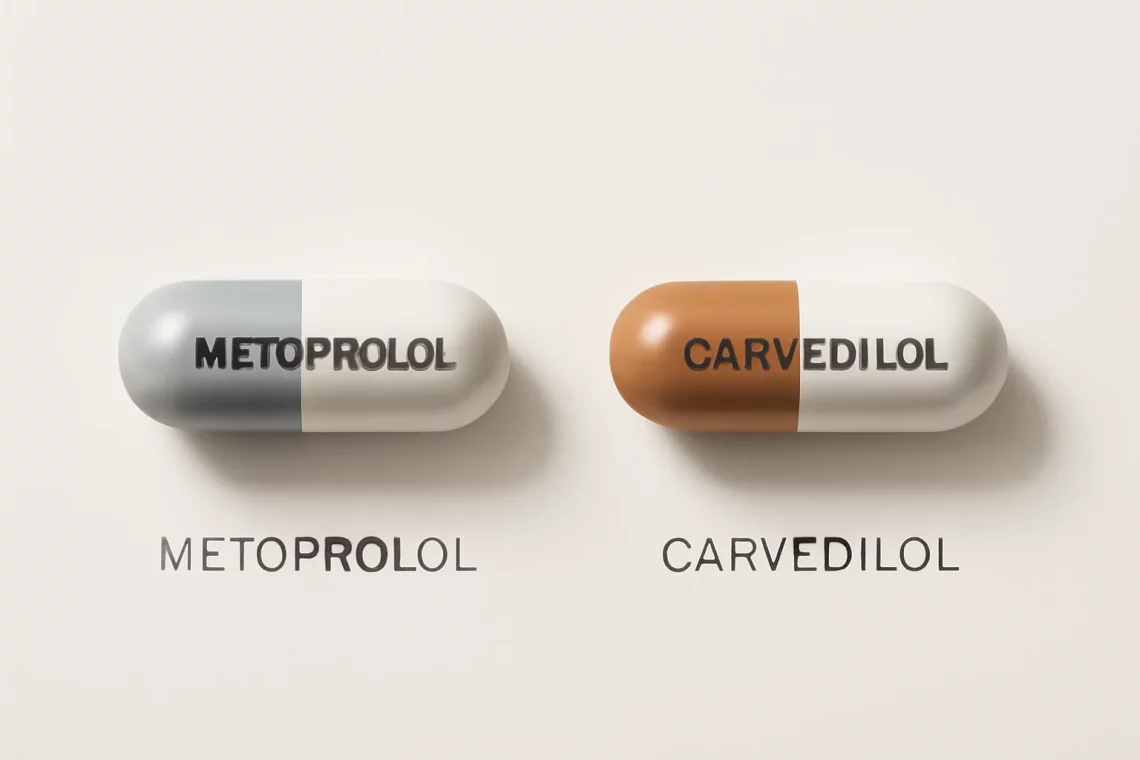
Metoprolol vs Carvedilol: Which Beta-Blocker is Right for You?
Metoprolol and carvedilol are both medications primarily used to manage cardiovascular conditions, but they belong to different classes of drugs and have distinct mechanisms of action. Understanding their differences, uses, and potential side effects is essential for patients and healthcare providers alike. While both medications are effective at treating high blood pressure, heart failure, and other heart-related issues, they have varying profiles that can make one more suitable than the other depending on individual patient needs.
As patients navigate their treatment options, it’s crucial to consider factors such as existing health conditions, potential interactions with other medications, and personal health goals. The choice between metoprolol and carvedilol often comes down to these nuanced considerations, which can significantly impact treatment efficacy and patient quality of life. In this article, we will explore the characteristics of both medications to provide a clearer perspective on their use in clinical practice.
Understanding Metoprolol: Uses and Benefits
Metoprolol is a selective beta-1 adrenergic blocker that primarily affects the heart. It works by inhibiting the action of certain chemicals in the body, leading to a decrease in heart rate and blood pressure. This medication is commonly prescribed for various conditions, including hypertension, angina pectoris, and heart failure.
One of the main benefits of metoprolol is its ability to reduce the workload on the heart, making it an effective treatment for patients with heart-related ailments. The drug helps to alleviate symptoms such as chest pain and shortness of breath, contributing to an improved quality of life. Moreover, metoprolol is often favored for its relatively favorable side effect profile compared to non-selective beta-blockers, making it a preferred choice for many patients.
Metoprolol is available in both immediate-release and extended-release formulations, offering flexibility in dosing regimens. The extended-release version allows for once-daily dosing, which can enhance patient compliance. Additionally, metoprolol has been shown to have cardioprotective effects, particularly post-myocardial infarction, reducing the risk of further heart complications.
Despite its many benefits, metoprolol is not without its potential side effects. Common side effects may include fatigue, dizziness, and depression. In some cases, patients may experience more severe reactions, such as bradycardia or respiratory issues. It’s essential for individuals taking metoprolol to have regular check-ups with their healthcare provider to monitor their response to the medication and make any necessary adjustments.
Overall, metoprolol remains a widely used and effective treatment option for various cardiovascular conditions, offering significant benefits when used appropriately.
Exploring Carvedilol: Mechanism and Applications
Carvedilol is a non-selective beta-blocker that also possesses alpha-1 blocking properties, making it unique among beta-blockers. This dual action allows carvedilol to lower blood pressure not only by reducing heart rate but also by causing vasodilation, which helps relax blood vessels. This mechanism can be particularly beneficial for patients with heart failure and hypertension.
The primary indications for carvedilol include the management of heart failure, hypertension, and left ventricular dysfunction following a heart attack. By improving heart function and reducing the risk of hospitalization due to heart failure, carvedilol plays a crucial role in the long-term management of patients with significant cardiovascular risk.
One of the advantages of carvedilol is its positive impact on mortality associated with heart failure. Clinical studies suggest that carvedilol can improve survival rates among patients suffering from this condition, making it a staple in heart failure management protocols. Additionally, carvedilol tends to have a mild effect on insulin sensitivity, which can be an advantage for patients with diabetes.
However, like all medications, carvedilol comes with potential side effects. Common side effects include dizziness, fatigue, and hypotension. More serious side effects can occur, such as worsening heart failure or liver function abnormalities. Patients should be aware of these potential risks and have open discussions with their healthcare providers regarding any side effects they experience.
In summary, carvedilol is a versatile medication with a range of applications in cardiovascular health. Its unique mechanism of action and proven benefits make it an important option for managing heart conditions effectively.
Comparing Side Effects and Safety Profiles
When considering metoprolol and carvedilol, evaluating the side effects and overall safety profiles of each medication is critical. Both drugs can lead to common side effects, but there are notable differences in how they may affect patients.
Metoprolol’s side effects tend to be more centered around fatigue, dizziness, and potential mood changes, such as depression. Since it is a selective beta-blocker, it generally has a lower risk of causing bronchospasm, making it a safer choice for patients with respiratory conditions like asthma.
On the other hand, carvedilol’s broader action can lead to a different set of side effects. Due to its alpha-blocking properties, carvedilol can cause more pronounced hypotension, especially when starting treatment or increasing dosages. Patients may experience lightheadedness when standing up, which is a result of the blood vessels dilating more than usual.
Both medications require careful monitoring, particularly in patients with pre-existing conditions like diabetes, renal impairment, or those who are pregnant. Carvedilol, for instance, must be used cautiously in individuals with advanced liver disease due to its metabolism in the liver, while metoprolol may require dose adjustments in patients with significant renal impairment.
In addition to individual responses, the potential for drug interactions should be considered. Both metoprolol and carvedilol can interact with other medications, leading to either increased side effects or reduced efficacy. Therefore, it is essential for patients to inform their healthcare providers of all medications, supplements, and over-the-counter drugs they are taking.
Ultimately, the decision between metoprolol and carvedilol should be based on a comprehensive assessment of the patient’s health history, the specific cardiovascular condition being treated, and individual patient preferences.
Making the Right Choice: Patient Considerations
Choosing between metoprolol and carvedilol involves several considerations that patients and healthcare providers must discuss openly. The choice should be individualized, taking into account the patient’s specific health needs, lifestyle, and treatment goals.
First and foremost, the underlying condition being treated plays a significant role in this decision. For patients with heart failure, carvedilol may be the preferred option due to its proven benefits in improving survival rates. Conversely, metoprolol may be more appropriate for patients with isolated hypertension or those who require a medication that minimizes respiratory issues.
Patient tolerance to medications is another crucial factor. Some individuals may respond better to one medication over the other, and side effects can vary significantly among patients. Therefore, it is vital to monitor how a patient responds after initiating treatment and to remain flexible in adjusting the medication regimen.
Additionally, lifestyle considerations, such as adherence to medication schedules and the complexity of the dosing regimen, should be addressed. Metoprolol’s once-daily extended-release formulation can be appealing for patients who prefer a more straightforward medication routine.
Furthermore, patient education is essential. Understanding how each medication works, the importance of adherence, and recognizing potential side effects can empower patients in their treatment journey. Open communication with healthcare providers ensures that patients feel comfortable discussing any concerns or side effects that arise.
In conclusion, the decision between metoprolol and carvedilol should be guided by a thorough evaluation of the patient’s health status, preferences, and goals. By considering these factors, patients and healthcare providers can collaboratively determine the most effective treatment plan for managing cardiovascular conditions.
**Disclaimer:** This article is for informational purposes only and does not constitute medical advice. Always consult a healthcare professional for medical concerns or before starting any new treatment.




